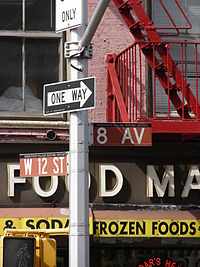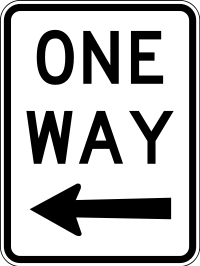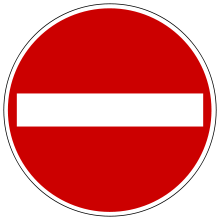- One-way traffic
-
One-way street in New York City.

One-way traffic (or uni-directional traffic) is traffic that moves in a single direction. A one-way street is a street either facilitating only one-way traffic, or designed to direct vehicles to move in one direction.
Contents
Signage
General signs
Signs are posted showing which direction the vehicles can move in: commonly an upward arrow, or on a T junction where the main road is one-way, an arrow to the left or right. At the end of the street through which vehicles may not enter, a prohibitory traffic sign "Do Not Enter", "Wrong Way", or "No Entry" sign is posted, e.g. with that text, or a round red sign with a white horizontal bar. Sometimes one portion of a street is one-way. another portion two-way. An advantage of one-way streets is that drivers do not have to watch for cars coming in the opposite direction on this type of street.
In addition to one-way streets, one-way traffic is also seen on highway entrance and exit ramps.
No entry signs
"No entry" redirects here. For the 2005 film, see No Entry.The abstract 'No Entry' sign was officially adopted to standardization at the League of Nations convention in Geneva in 1931. The sign was adapted from Swiss usage. The Swiss, in turn, adopted the practice of former European states that marked their boundaries with their formal shields and, when not wishing visitors to enter, would indicate so by tying a blood-red ribbon horizontally around the shield.[citation needed] The sign is also known as C1, from its definition in the Vienna Convention on Road Signs and Signals.
The European 'No Entry' sign was adopted into North American uniform signage in the 1970s, replacing its rectangular, white "Do Not Enter" sign, although the U.S. version retains the wording "Do Not Enter" where the European and Canadian version typically has no wording on it.
Since Unicode 5.2, the Miscellaneous Symbols block contains the glyph ⛔ (U+26D4 NO ENTRY), representable in HTML as
⛔or⛔.Location of one-way streets
One-way streets may also be part of a one-way system, which facilitates a smoother flow of motor traffic through, for example, a city centre grid; as in the case of Bangalore, India. This is achieved by arranging one-way streets that cross in such a fashion as to eliminate right turns (for driving on left) or left turns (for driving on right). Traffic light systems at such junctions may be simpler and may be coordinated to produce a green wave.
Reasons for being one-way
- The street is too narrow for movement in both directions and the road users unable to co-operate.
- To prevent drivers from cutting through residential streets (rat runs) to bypass traffic lights or other requirements to stop.
- Part of a one-way pair of two parallel one-way streets in opposite directions (a divided highway).
- For a proper functioning of a system of paid parking or other paid access. Traditional names for such products are: traffic spikes, tiger teeth, alligator teeth, tire spikes, and flow plates.
- To calm traffic, especially if the street is historic[citation needed].
- To eliminate turns that involve crossing in front of oncoming traffic.
- To increase traffic flow and potentially reduce traffic congestion.
- Eliminate the need for a center turn lane that can instead be used for travel.
Special Rules
Left Turn on Red
In the U.S., 37 states and Puerto Rico allow left turns on red only if both the origin and destination streets are one way. See South Carolina law [1] Section 56-5-970 C3, for example. Five other states, namely Alaska, Idaho, Michigan, Oregon and Washington, allow left turns on red onto a one-way street even from a two-way street.[2][3][4][5]
History
The first one-way street was established in Lima, the capital metropolis of Peru.[citation needed] The first one-way street in London was Albemarle Street in Mayfair, the location of the Royal Institution. It was designated London's first one-way street because the public science lectures were so popular there. [1] The first one-way streets in Paris were the Rue de Mogador and the Rue de la Chaussée-d'Antin, created on 13 December 1909.
One story of the origin of the one-way street in the United States originated in Asbury Park, NJ. On 9 September 1934, the on fire SS Morro Castle [2] was towed to the shore near the Asbury Park Convention Center, the sightseeing traffic was enormous. The Asbury Park Police Chief decided to make the Ocean Avenue one-way going North and the street one block over (Kingsley) in one-way going south creating a circular route. By the Fifties this cruising the circuit became a draw to the area in itself since teens would drive around it looking to hook up with other teens. The circuit was in place until the streets went back to two way in 2007 due to new housing and retail development.
One-way traffic of people
 Some countries, like Germany, show text on one-way signs. ("Einbahnstraße" means one way street.)
Some countries, like Germany, show text on one-way signs. ("Einbahnstraße" means one way street.)
Sometimes there is one-way walking for people, for smooth traffic flow, or in the case of entrance checks (such as ticket checks) and exit checks (e.g. the check-out in a shop). They may be outdoors, e.g. an extra exit of a zoo, or in a building, or in a vehicle, e.g. a tram.
 Such type of road signs used in Russia
Such type of road signs used in Russia
In addition to just signs, there may be various forms and levels of enforcement, such as:
- personnel
- a turnstile; turnstile jumping is possible
- a High Entrance/Exit Turnstile (HEET)
- a door or gate that can only be opened from one side (a manual or electric lock, or simply a door that is pushed open and has no doorknob on the other side), or automatically opens from one side; with help from someone on the other side, it can usually conveniently be passed in the "wrong" direction. Examples:
- entrance of a shop
- an emergency exit; it may activate an alarm, useful both for proper and improper use of the door
- an escalator; the escalator can be passed in opposite direction, climbing up or down the stairs faster than it moves
- a one-way revolving door
Sometimes a "soft" traffic control system is supported by personnel keeping an eye on things.
Sometimes a door or gate can be opened freely from one side, and only with a key or by inserting a coin from the other side (house door, door with a coin slot, e.g. giving entrance to a pay toilet). The latter can be passed without paying when somebody else leaves, and by multiple persons if only one pays (as opposed to a coin-operated turnstile).
References
Traffic signs Signs Warning sign · Regulatory sign · Priority to the right · Yield sign · Stop sign · Prohibitory traffic sign · One-way traffic · Speed limit (by country) · Advisory speed limit · Mandatory sign · Special regulation sign · Information sign · Direction, position, or indication sign · Variable-message sign · Bilingual sign · Comparison of European traffic signs · Driver location signs · CrossbuckBy country Lights Typefaces Allerta · Austria (typeface) · Clearview · DIN 1451 · Drogowskaz · FHWA Standard Alphabets for Traffic Control Devices · Frutiger · Caractères · NPS Rawlinson Roadway · Trafikkalfabetet · Transport · TratexConventions Geneva Convention on Road Traffic · Vienna Convention on Road Traffic · Vienna Convention on Road Signs and Signals · Manual on Uniform Traffic Control Devices (USA) · Traffic Signs Regulations and General Directions (UK)Categories:- Types of roads
Wikimedia Foundation. 2010.




